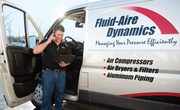As a business owner, or even as a great employee, you’re probably always thinking of ways to improve your company’s efficiency. Industrial air compressors are used in many different industries all over the world for a variety of critical operations. One of the best ways to reduce energy consumption — and save on energy bills — is to reduce energy waste in your compressed air system. Read on to learn 10 tips for reducing air consumption and energy costs.
Remember, compressed air is not only your 4th utility, but also your most expensive utility.
1. Minimize Pressure Drop
Pressure drop in a compressed air system is the loss of air pressure due to resistance in the system as air moves through pipes, filters, and other components. This makes the compressor work harder and increases energy consumption and compressed air costs, so you’ll want to prevent pressure drops as much as possible.

While you can’t fully eliminate pressure drop, you can minimize pressure drop through careful system design and maintenance. Steps you can take include:
- Use adequately sized pipes for the compressed air piping system and best practices in piping system design to ensure unrestricted airflow.
- Make sure filters are sized appropriately to avoid bottlenecks and change inline filters as they become loaded.
-
Find and fix air leaks on a regular basis to prevent air loss.
- Ensure adequate air storage to stabilize pressure and reduce fluctuations in demand.
2. Install Low Pressure Drop Filtration

Installing filtration designed for low pressure drop is an effective way to minimize air resistance and energy consumption in your compressed air system. Low pressure drop filters allow air to pass through more easily, improving energy efficiency and reducing the overall load on your air compressor.
Also, avoid excessive filtration; higher filtration efficiency (the ability to remove smaller contaminants) will also result in higher pressure drop. Unless your applications require ultra-clean air, filters capable of removing submicron particulate are an unnecessary expense.
3. Run Your System Pressure at the Lowest Possible PSI
Setting your system pressure to the lowest possible PSI level while still ensuring correct operation can significantly reduce or eliminate unnecessary air consumption. As a rule of thumb, for every 2 PSI reduction in system pressure, energy costs decrease by about 1%.
To make this feasible, focus on reducing pressure drop across the system and establishing an optimal operational pressure band that supports all processes without waste. Reducing fluctuations in system pressure and keeping it within a stable, lower range can provide consistent efficiency gains and energy savings.
4. Install Zero Air Loss Condensate Drains

Solenoid-type timer drains are very commonly used because of their cost-effectiveness and simplicity, but here is the fact: a standard timer-type solenoid valve with 5/32” orifice that is set to purge for 10 seconds every 10 minutes at 100 PSI will use 40 cubic feet of air every hour. Based on a 24/7/365 operation and an energy cost of $0.10 per kW/h, these valves could cost you nearly $150.00 each in wasted energy per year!
Your energy company may provide rebates or energy incentives to replace timer drains with energy-efficient Zero Loss Drain Condensate Drains. With these incentives, your ROI may be less than one year.
5. Upgrade to a Variable Speed Drive Compressor
Variable speed drive compressors (VSD air compressors) can significantly reduce energy use for air compression, especially if your air demand fluctuates by shift, day or season. VSD compressors save energy by adjusting the speed of the motor in response to actual air demand; when demand is low, the compressor reduces motor speed and energy usage.
Costs for VSD compressors have come down, and many energy companies offer energy incentives that offset some or even most of the cost of an upgrade. In addition to that, the ongoing energy savings in many cases can save your company hundreds, if not thousands, of dollars per month if the machine(s) are properly sized and implemented.
6. Install Cycling Dryers When Practical
The energy draw is significantly lower on refrigerated air dryers than air compressors, so replacement of a working non-cycling dryer with a cycling dryer is rarely warranted. However, if it’s time to replace your air dryers anyway, it makes sense to consider more energy-efficient appliances. Cycling air dryers (AKA demand-based or load-responsive dryers) are designed to save energy by only running the refrigeration compressor when cooling is needed.
If your air dryer is significantly oversized, or your demand is dramatically different from season to season or shift to shift, it may make sense to upgrade to a cycling dryer. VSD air dryers are another option for those seeking energy-efficient appliances. Your energy company may have incentives to offset the cost of energy-efficient air dryers.
7. Install Purge Regulation/Reduction on Desiccant Air Dryers

Desiccant-type air dryers work by passing compressed air through a chamber filled with desiccant material, which absorbs moisture from the air. The desiccant material must be periodically recharged, most commonly by applying heat or purging with dry air.
Purge controls in desiccant air dryers regulate the amount of air used to regenerate the desiccant material, saving energy by minimizing unnecessary air loss. These systems save energy by using sensors to monitor the moisture level and adjust the purge cycle accordingly. Heat-of-compression desiccant dryers are particularly efficient, using the heat generated during compression to assist with drying. Purge regulation is typically installed with the initial investment, but may also be possible as a retrofit — and your energy company may help cover the cost.
8. Install Properly Designed Air Nozzles Everywhere

Installing properly designed air nozzles throughout your system can drastically improve energy efficiency and reduce energy consumption. Unlike open copper tubes or DIY solutions like pipes with drilled holes, air nozzles focus the air stream, providing greater power with less compressed air. This focused airflow minimizes waste, allowing equipment to operate effectively at lower pressures.
Not only does this save energy, but it also reduces operational costs over time. By replacing inefficient setups with engineered air nozzles, you can save money while achieving optimal performance.
Contact Us Today!
866-435-2717
We are able to assist in compressed air system design and optimization to reduce energy usage.
9. Improve Compressor Controls and Install System Controllers Where Possible
Modern compressor controls and central supply-side controllers offer effective ways to automate and optimize air compressor operations. For single compressors, automation ensures the unit doesn’t run during non-production hours, helping you reduce your energy use and costs. For systems with multiple compressors, a central supply-side controller turns compressors on and off based on plant demand, which is ideal for managing a narrow pressure band and lowering overall system pressure.
Investing in these controls supports a more sustainable future by conserving energy and minimizing waste.
10. Use Low-Pressure Blowers Where Possible

When your application requires air below 40 PSI, consider switching to a low-pressure
commercial air compressor or blower.

These alternatives consume significantly less energy than standard compressors, potentially saving up to 90% on energy bills.
By reducing the load on your main compressor, low-pressure blowers also lower air compressor maintenance needs, cutting down on operational costs and contributing to a more energy-efficient system. This simple change can significantly reduce energy costs and make a big impact on system sustainability.
Optimize Your Compressed Air System and Reduce Energy Use Today!
Optimizing your compressed air system with the strategies outlined above can drastically improve energy efficiency, reduce electricity consumption, and stop wasting compressed air in your facility. At Fluid-Aire Dynamics, our highly trained technicians and engineers specialize in enhancing the performance of most compressed air systems. From installing efficient nozzles to upgrading controls and conducting comprehensive system audits, we’ll help you save money and make your air production as efficient as possible.
Explore our compressed air audit services to see how we can support your goals, or contact us for personalized assistance.





